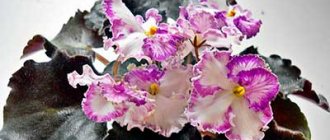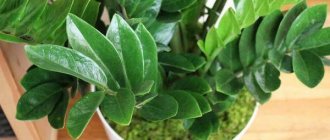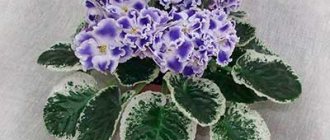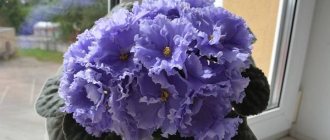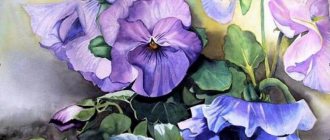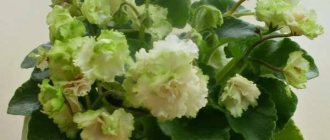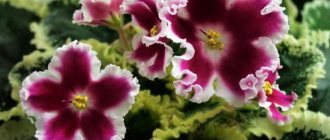Violet, description and photo of Dozhdinka (K. Morev)
Violets from breeders of the CIS countries - “D-2”.
Rain (K. Morev).
Large lilac-pink, deep-double stars with fringed edges and blue fantasy touches.
Dark green, shiny, quilted, rounded foliage. The leaves have slightly elongated petioles and bend slightly downwards. Small standard. A small, neat, regularly shaped outlet.
Double and semi-double flowers, lavender-pink background and blue fantasy splashes, like streaks of rain. There is a white border along the edge of the petals. There should be white shades on the petals. The flowers are large, about 6 cm in size. Each plant blooms differently.
As the rosette ages, the flowers become much brighter, darker and more fantasy. The color of the petals in daylight is bright and expressive, the border is clear. Towards the end of flowering the color fades a little. In hot weather, the border is weakly defined; in autumn it is brighter.
Blooms with a neat cap. It blooms almost without interruption, the flowers last a long time. The peduncles are rather weak and when there are a lot of flowers, they cover the rosette.
Grows and blooms quickly. It grows a little slowly during the transition from baby to starter, but then it blooms quickly. Sometimes gives blue sports.
Dozhdina is a raindrop.
Do you know that…?
When growing a two-color variety, you need to leave at least two rosettes in the collection and then, after waiting for flowering, choose the most beautiful one. If everything is in order, and the specimen has successfully repeated the required color, the size of the colored spot (as well as the size of the eye) may vary between different specimens - some are larger, some are smaller. In addition, the ratio of these two differently colored areas can vary during the life of one individual plant.
When violets are kept in excessively warm conditions, the border of the petals may well become thinner or even partially disappear. This phenomenon is usually temporary. The green or light green border turns white in unfavorable conditions, and the wide border becomes thin. In addition, similar properties of the border (width, green tint) may not be fully manifested during the first flowering, and only then are most expressed in mature, well-developed specimens.
Before you buy the violets listed below, carefully read the forums about their behavior on the windowsill. Many of them are very beautiful flowers. However, these can be large rosettes with large and fragile leaves, with leaves rising up or hugging the pot, forming many stepsons that interfere with the formation of a neat rosette, pulling the stem up and growing into a Christmas tree, bending the trunk, rare flowering with long breaks, fallen flowers or they last little and quickly wither, very long and recumbent peduncles, the color of the flower fades quickly, they do not like bright lighting on the windowsill, they are afraid of the slightest drying out or waterlogging, a large percentage of them go into sports or darken the flower.
Are they suitable for your window sill and the conditions that you can create for them? You will look at the flowers for several months, and the rosette will always be in front of your eyes. There are many beautiful flowers, there are much fewer beautiful and neat rosettes, look first at the rosette! Search and you may find a dozen violets with the same flower color if you are not interested in the smallest details as a collector.
• — Wedding Day (Lazarenko); • — Day by Day (Arkhipov); • — Curiosity (Morev); • — Brownie Kuzya (Burkatsky); • - Dulcinea (Prilutskaya);
March Rainbow: Dozhdinka (Morev), President (Makuni), EK-Lady Luck, EK-Magic of Love.
Found a mistake? Report it: 1) Select the error with the mouse 2) Press CTRL+Enter. Read more.
This is where my collection begins to bloom. I would like to show you a few violets that are currently blooming. I’ll start with the most, in my opinion, extraordinary one - Dozhdinka (Morev). The flowers are so huge that only two flowers fit on my straightened palm. Miracle variety!
Next of my favorites is President (Makuni). When this variety bloomed for the first time, I did not expect such an abundance of brightly colored flowers that attract the eye. This is the second flowering of my beauty. A “cap” is gradually formed, and very soon all the flower stalks will rise above the leaves.
And this is what she looked like a day later:
And now the primrose - EK-Lady Luck! Huge light pink flowers of a wonderful shade, lightly “powdered” with purple glitter. Along the edge of the petals there is a wide crimson-purple border.
And a closer look at the flower:
And another pretty variety, blooming for the second time; the peduncles, like soldiers, hold large double flowers with a white border. This is EK - Magic of Love:
The rest are still in buds. I'll wait for it to bloom.
Rain
Moderator: Floriana
Rain
Post by Inna S. » July 19, 2010, 2:21 pm
Saintpaulia Rain. Breeder K. Morev
Large lilac-pink, terry stars with fringed edges and blue fantasy touches. The leaf is dark green.
Re: Rain (Morev)
Post by Passific » 06 Jan 2011, 21:02
Dozhdinka (Morev)
Post by Selena » 06 Jan 2011, 21:12
Re: Rain
Post by Borisovchanka » July 31, 2015, 12:01
It's been a while since anyone showed anything in this thread. Here is my rain - the first flowering. I didn’t have time to take pictures right away - a brownish tint had already appeared around the edges of the flowers. But I'll show you anyway. Compact socket.
Re: Rain
Post by Ludok1976 » 05 Aug 2015, 21:19
Re: Rain
Post by Borisovchanka » 05 Aug 2015, 22:08
Re: Rain
Post by ROSA » 06 Aug 2015, 11:10
Re: Rain
Post by Natalya Shalamova » 06 Aug 2015, 14:41
Re: Rain
Post by Ludok1976 » 06 Aug 2015, 20:49
Re: Rain
Post by Ludok1976 » 06 Aug 2015, 20:50
Black fakir violet
Author: Elena Borovikova
Imagine that some 50-odd years ago the world did not know the splendor of violets that we see now. In those days there were only species Saintpaulias with lilac violet falling small flowers. All the variety of varieties would not have been possible without people passionate about breeding work. It is thanks to them that we become collectors of violets and every year we look through catalogs and order more and more new varieties, unable to stop. I will start my story with foreign breeders.
Lyndon Lyon (USA) achieved great success in the selection of violets, despite the fact that he completed only 10 classes of a 12-year school.
His fascination with Uzambara violets began in 1949, when he was given the first leaf. The first five years of his work on research and hybridization of violets were carried out at home, on wooden racks with artificial lighting. By the early 50s, the entire top floor was filled with shelving. Lindon was one of the first to use artificial lighting to grow violets.
When success came to Lyndon as a breeder, he began construction of three greenhouses (1954, 1956 and 1959). By 1955, as a result of breeding work, he already had 80 new varieties of violets, including pink terry, and produced 5,000 plants. His pink terry was the first double violet and with it he caused a sensation at the AVSA meeting in 1954. Lindon said that double violets were the future, and also predicted the appearance of yellow, bright red and true blue violets. Now all this is somewhat surprising, but in those days there were only lilac violet flowers. Lindon was the first to receive a violet with a star-shaped flower. In subsequent years, he worked on the selection of miniature violets, then became interested in streptocarpus and gloxinia.
By 1974, over 20 AVSA shows, Lyndon had won the New Commercial Introduction Award 10 times, won many different awards, medals, trophies, and repeatedly took first place in categories such as “Agricultural Excellence,” “Best Seedling,” “ best commercial exhibition.”
Perennial violets - luxury in miniature
In recent years, the popularity of these tiny plants among connoisseurs of discreet natural beauty has increased incredibly. Perennial violets - heralds of the arrival of warmth - are liked by many summer residents. This is one of my granddaughter Liechka’s favorite flowers: every year, tired of the cold winter, we anxiously and impatiently await their bloom in early spring.
Perennial violets - heralds of the arrival of spring
Today you will meet the most beautiful species, among which the palm belongs to the fragrant violet. Nature has endowed it not only with luxurious tiny flowers, but also with a luxurious aroma.
Fragrant violet, photo by the author
I did not include the most famous violet (or Wittrock’s viola) with its numerous varieties in the post, because it is grown mainly as a biennial, despite the fact that it is a perennial plant. Therefore, our attention will be completely focused on the original perennial violets, which we plant in our dachas once, and they delight us for many years.
Perennial violet is hooked and curved. Photo from heritageseedlings.com
A huge variety of perennial violets have long been successfully grown in Europe and Great Britain; We will talk about some in more detail, while others you will see only in photographs.
Perennial Aetolian violet. Photo from greekflora.gr
Surely the unusualness of some species will surprise and amaze you as much as it did me when preparing the article.
Perennial Beckwith violet with unusual gray-pubescent leaves. Photo from botanikim.com
The similarity of the requirements of perennial violets for sun, heat, water, and soil allowed me to combine the features of their cultivation and use in dachas.
Landing
The easiest way to acquire a “Black Prince” violet is to purchase a healthy, strong cutting of the plant at least 5 cm long, which can be rooted in water or immediately planted in prepared soil. Plastic pots with a diameter of no more than 5-6 cm are suitable for planting cuttings, children separated from the mother's outlet, and starters (young plants). For an adult plant, containers with a diameter of 9 cm are suitable. Ceramic pots are not suitable for growing violets: they are colder than plastic, and this is completely undesirable for Saintpaulias.
"Black Prince" is very unpretentious to the soil. It is enough that the substrate has low acidity, is loose, and allows air to pass well to the roots. The correct soil should contain:
- leavening agents - perlite, vermiculite, sphagnum, charcoal;
- organic additives - humus or humus;
- nutritional supplements – leaf soil, turf;
- the main fillers are a purchased ready-made mixture for violets or soil from a coniferous forest.
Important! Before use, the substrate must be disinfected in any available way:
- steam in the microwave;
- bake at high temperature in the oven;
- pour boiling water over well.
This guarantees the death of pests and bacteria living in the soil.
The planting mixture can be made in the following proportions:
- ready-made nutrient soil – 1 part;
- peat – 3 parts;
- perlite – 1 part;
- charcoal - 1 part.
To plant you need:
- choose good planting material - a leaf from the second row of the “Black Prince” rosette;
- if the cutting has been on the road for a long time and looks lethargic, restore the plant’s strength by immersing it in warm water with a weak solution of potassium permanganate for 1 hour before planting;
- cut the cuttings for rooting at an angle of 45 degrees, departing 2-3 cm from the leaf plate;
- place drainage (expanded clay or activated carbon) into the pot to fill 1/3 of the volume and fill with prepared soil;
- in moistened soil, make a hole no more than 1.5 cm deep and carefully place the cutting there;
- for comfort, the plant should be covered with a glass jar or plastic bag and transferred to a warm, well-lit place;
- From time to time, open the mini-greenhouse to ventilate and drip moisten the soil.
After small baby leaves appear in the pot after 4-5 weeks, they need to be transplanted from the mother leaf - each to a new place of residence, in its own small pot. Rooting was successful, and now you will have a new, unusually beautiful plant.
At least 5 months will pass and, as a reward for your work and patience, your own “Black Prince” will give you its first flowering.
Lighting
Like all violets, "Black Prince" needs good lighting. For a plant to bloom, its daylight hours must be at least 12 hours. If the outlet does not receive enough light, the plant will look exhausted:
- leaves are pale, limp;
- the trunk extends towards the light source;
- flowering is completely absent.
The best places for the “Black Prince” to live in an apartment are the window sills of the northern and western windows, where it does not get very hot. In summer, plants will be comfortable here, but in winter they need to be illuminated with special lamps or LED lamps.
This is essential for good growth and abundant flowering of plants.
You can place the “Black Prince” on a south window only if you have covered the window glass with plant protection film or shaded it with curtains. The bright scorching rays of the sun are destructive to violets. Here they can only spend the winter quietly, and with the appearance of the bright spring sun, the flowers can be placed on a rack located at a safe distance from the window.
A rack with artificial lighting for indoor violets can be arranged not only in a room with windows facing south, but also in any other place in your apartment or office. This is an excellent way out for those who have:
- there is very little light; opposite the windows there are large buildings or spreading trees that provide shade;
- window sills that are too narrow to accommodate pots;
- stuffiness - windows and vents have to be opened often.
“Black Prince” feels most comfortable on the shelf on the second shelf from the bottom - it’s cooler here.
Watering
The humidity of the room where the plant lives should be at least 50%. Watering should be moderate:
- Do not leave the earthen ball completely dry;
- Overwatering the plant threatens to rot the root system and kill the violet.
Spraying and watering the plant at the root are not carried out. Let's look at the correct ways to water violets.
- Using a wick (natural cord or strip of fabric), one end of which is immersed in a vessel with water, and the other in a drainage hole. The bottom of the pot should not be wet or in water.
- Through the pot tray. You need to pour enough water into it so that it covers it by no more than ¼. After watering, excess water is removed from the pan.
- A syringe or watering can with a long thin spout. “Black Prince” should be watered by drops strictly along the edge of the pot, and do not pour water on the rosette itself or under its root.
The nuances of growing perennial violets
These are mainly forest plants, for which shady and semi-shaded places in summer cottages are optimal, but they can also grow in well-lit areas. They love fertile loamy, moist soils, so caring for them is indispensable without watering. For more luxurious flowering, it is necessary to feed with complex mineral fertilizer (according to the instructions) during the budding period. When growing in vases, pots, containers, it is better to use a soil substrate consisting of humus, turf soil and sand, taken in a ratio of 2:1:2. Some varieties are suitable for growing in hanging baskets. Most species are winter-hardy in central Russia, but varietal varieties require light shelter for the winter.
Fragrant violet as a ground cover plant, photo by the author
In comfortable conditions, violets sometimes produce abundant self-seeding, which can be avoided by timely removal of faded flowers or seed pods. It must be remembered that some species are characterized by 2 types of flowers that produce many seeds: the main ones and the “last ones” (appear after the main ones, on short stalks, without petals). Violets are propagated by seeds during winter sowing and by dividing rhizomes in August-September.
Using perennial violets in the country
Grown in the country as ground cover plants:
- f. fragrant;
- f. Labrador;
- f. white.
Grown as accent spots on the lawn:
- f. fragrant;
- f. Labrador;
- f. white;
- f. Altai;
- f. tiny.
Look luxurious in spring in rocky gardens:
- f. fragrant;
- f. Labrador;
- f. white;
- f. Altai;
- f. tiny;
- f. Manchurian;
- f. moth and others.
Fragrant violet among the stones.
Photo from the website swallowtailgardenseeds.com They feel great near ponds and bloom profusely:
- f. swamp;
- f. moth;
- f. bald.
A low border made of f. will be very cute and attractive. Labrador, or f. moth planted along the garden path leading to the recreation area. More refined and demanding types and varieties of violets are best placed in containers, wide low or high garden flowerpots.
Altai violet (Viola altaica)
It is highly frost-resistant and winters well in central Russia without shelter. This species first appeared in St. Petersburg at the end of the 18th century.
Altai violet. Photo from species.wikimedia.org
It comes from, as the specific name suggests, from the alpine zone of Altai, Sayan, mountains around Baikal, and Tien Shan. It is a rhizomatous perennial up to 20 cm high, the leaves are round or oblong-ovate, with a crenate edge, on long petioles. The flowers are solitary, blue-violet, with a yellow spot, white or cream, with blue stripes on the lower petals. In April it blooms for 40-45 days; repeated (but not as abundant) flowering can be observed in August.
Botanical description [edit | edit code ]
Perennial herbaceous plant, 20-40 cm tall. The rhizome is thick, woody, covered with rusty-brown scales. A stem with shortened internodes and a rosette of basal leaves develops after the first flowers appear. The basal leaves are entire, broadly ovate, with a kidney-shaped or rounded-heart-shaped base, with shallow notches along the edge, glabrous or slightly pubescent with short hairs, located on long petioles, with ovate-lanceolate stipules with an entire or notched-toothed edge.
Flowers are solitary. In spring, chasmogamous, mostly sterile flowers appear in the axils of the basal leaves. A little later, cleistogamous, fertile flowers grow on the stems that appear after the first flowers. Sepals 5, large, lanceolate, equal in length. The sterile flowers are zygomorphic (irregular) and have five light purple unequal free petals. The petals are rounded-ovate, the two lateral ones are pubescent at the base, inclined towards the lower petal, the lower petal is bare, larger than the rest, the upper two are bent upward. Cleistogamous flowers are small, inconspicuous, similar to unopened buds. There are five stamens. The ovary is superior, unilocular. The style is short, simple, the stigma is thickened, with a downward curved nose.
The fruit is a triangular, loculicidal (nest-bursting), naked, oblong-ovoid capsule, when ripe it opens with three valves and throws out seeds.
Flowering in April - June.
Fragrant violet (Viola odorata)
It is known that this particular species was introduced into culture in 1542 by monks in the territories of European monasteries. Currently it is called English violet, garden violet, and candy violet. She comes from Southern and Western Europe.
Fragrant violet, photo by the author
A rhizomatous semi-evergreen perennial 20 cm high and 30 cm wide, with a thick creeping rhizome, numerous rosettes of basal heart-shaped leaves, above-ground shoots rooting at the nodes, and single flowers up to 2.5 cm in diameter. Here, on the southern coast of Crimea, it overwinters without shelters while remaining green. Already in March, at my dacha it blooms with inky fragrant flowers on low (10-15 cm) peduncles. In central Russia, the main flowering occurs in April - May; a second wave may occur at the end of summer.
Decorative varieties:
- ' Christmas ' – white flowers;
Fragrant violet 'Christmas'. Photo from vivaipriola.it
- ' Coeur d'Alsace ' – pink flowers;
Fragrant violet 'Coeur d'Alsace'. Photo from vivaipriola.it
- ' Red Charm ' – red-purple flowers and others.
Fragrant violet 'Red Charm'.
Photo from the site vivaipriola.it The specific subtle and delicate aroma of fragrant violet is liked by many summer residents. Some ladies prefer to hear its notes at any time of the year in their favorite scents: “Champs-Elysees”, “Violette”, “Fidele Violette” and others.
Fragrant violet, photo by the author. Perfume "Champs-Elysees". Photo from the site royalparfums.com.ua
A long time ago, Parma violets were popular, and in winter they were everywhere driven out in greenhouses and hothouses. Their unique sweetish aroma belongs to the world-famous Parma variety of fragrant violet (Viola odorata var. parmensis).
TOP 10 varieties
Among all the black varieties, the ten most popular ones can be distinguished; they are distinguished by their richness of color, beauty of shapes and leaves. Each of these varieties has its own characteristics, and each of them is beautiful in its own way.
Mac's Black Pearl
The rosette is semi-miniature, the leaves are small, the cuttings are slightly elongated. The leaf is round, medium green, serrated, the edges are slightly curved down.
Despite its compactness, the rosette is sloppy and tends to lift leaves; To eliminate the problem, a fairly long daylight hours is required. Green grows slowly, rosette up to 17 cm.
The flowers are simple nuisances, small, up to 2.5 cm, bloom almost continuously, the peduncles are elongated and erect. The color of the flowers is almost black, with different lighting designs having a white, blue or burgundy-purple pencil border around the edge of the petals.
Each bud slowly opens and lasts up to 2 weeks, then gradually, imperceptibly fades, turning into a dried flower right on the peduncle.
Apache Midnight
Diversity of foreign selection. The ceiling rose is large, more than 30 cm, the size is obtained due to the size of the metal plate. The leaves are variegated, dark green with white-pink, slightly spoon-shaped.
The flowers are semi-double, medium-sized, pansy-shaped. The color is purple-burgundy, very dark, close to black. There is a thin white border along the edge. The flowering is quite abundant, the cap is small, there are 2-3 flowers on the peduncle.
The variety is slow-growing; cuttings usually have few pups, 1, 2, sometimes 3. The first flowering can last up to a year; on average, individuals are one and a half years old.
This variety is recommended to be replanted more often than others, but it is strictly forbidden to overwater.
Important! The white edge and light parts of the leaf look best in cool areas with slightly dim light.
Mac's Black Uhuru
A semi-miniature bush of irregular shape, leaves of different sizes, up to 17 cm in diameter. The leaves are round, very textured, all with tubercles and with clear yellowish lines above the veins, swamp green in color. The leaf blades are large, and the cuttings are shortened.
The flowers are large, like semimino, very double, like small roses. The color changes as the bud blooms, at first completely black, then increasingly acquiring a purple tint, the brightness of the flowers depends on the lighting.
The peduncles are short, strong, with 3-5 buds on each. It blooms for a long time, with a beautiful bouquet from the first flowering.
Important! It is very demanding in terms of care, it is important to follow all the nuances, otherwise the plant will easily die. When breeding, it produces many young and often forms stepsons on the bush.
Purple Passion
Variety of standard sizes. The leaves are large, dark green, slightly wavy. The rosette is quite loose, the leaf cuttings are long and strong. The shape of the leaves is round, with a pronounced base.
The flowers are very double, with a pronounced wavy edge and are large in size. The color of the flowers is dark purple, almost black with proper care. Towards the edge of the petals the color is darker, along the edge there is a pronounced white-green flounce.
AV-Noble Rose
Saintpaulia is a standard size, the rosette is fairly uniform, horizontal, and tends to slightly hug the vase of leaves. The leaves are light green, slightly elongated, pointed at the ends, with fine teeth along the edge. The leaf cuttings are of medium length and do not spoil the appearance of the rosette.
The flowers are large, quite double with a wavy edge of the petals, and their shape resembles a strongly open rose. The color of the flowers is burgundy-black, changing towards the light as they bloom.
AB-Inkheart, sports
Large grip on the border between standard and large. The leaves are very large on small cuttings, intense green in color, with a noticeable network of capillaries and a wavy edge. The leaves tend to grow in different directions, sometimes breaking the horizontal rosette.
Terry's flowers, unlike the original AV-Ink Heart variety, are even darker. The color of the petals is purplish-black with a light green, pencil-like outline and slight ripples along the edge.
AN-Black Tulip
The grip is standard size, slightly clumsy. The leaves are smooth, shiny, dark green. Spreading the plaque, the flower stalks gradually rise, scattering rosettes around the perimeter. Usually produces three buds on each peduncle.
The flowers are small, bell-shaped, close at night and open during the day, but not completely. The color of the flowers is dark purple, often close to black. The variety may have coral, fancy spots, but this is not necessary.
During the flowering process, the color gradually changes from dark to lighter, with the center of the flower always darker than the main part.
LE-Demo
The bush is of a standard size, symmetrical, easy to form, and can slightly hug a pot with leaves. The leaves are variegated, rounded, with slight wavy and fine teeth along the edge.
The flower stalks are strong, there are usually a lot of them, but the flowering is not very abundant, very often a small bunch blooms. The flower is medium-sized, double, the petals are slightly curved outward.
The color of the petals is very rich, dark blue, almost black, darker towards the edges. Along the slightly wavy edge is the point of a pencil.
RS-Milord
The rosette is medium-sized, flat, with fairly large leaves. The leaf is round, slightly curled along the edge, dark green in color. The bush forms well on its own, but with insufficient lighting it can lift the leaves a little.
The flowers are incredibly coloured, shaped like a simple star with a wavy edge, a bit like a bell, but with separate and more open petals.
The color comes with a gradient from the center to the edge, where the center is purple-black and the edge is completely white. The ratio of darkness and light in a flower depends on light and temperature; the warmer and brighter the place allocated to the flower, the larger the dark part.
AE-Witching Night
The bush is uneven, the leaves tend to curl and lift, and are medium in size. The leaf is dark green with a wavy, rounded edge, rather large on a short handle.
The flowers are quite simple in shape - round stars with small ripples along the edge. The color of the petals is dark purple, darker towards the edges, often reaching black. Along the edge there is a light green and white pencil border.
The peduncles are tall, and therefore flowering with a cap is almost impossible; usually 3-4 buds bloom on one peduncle.
Horned violet (Viola cornuta)
Especially loved in Europe. She comes from the highlands of France, Spain, and Italy. In culture since 1776
Horned violet. Photo from ru.wikipedia.org
It is a creeping rhizomatous evergreen perennial 15 cm high and 40 cm wide, producing dense mats. Violet, lilac, blue flowers with a small yellow eye and a characteristic horn-shaped spur bloom from May (mass flowering) and throughout the summer (single). Blooms profusely: 1 plant can have up to 60 flowers.
Horned violet 'Alba Minor'. Photo from gaissmayer.de
Decorative form:
- var. minor - up to 7 cm high, up to 20 cm wide, smaller flowers, 15-2 cm in diameter, from white to lavender-blue.
Dog violet (Viola canina)
Lovers of the landscape style of dachas will certainly appreciate this delicate violet. It comes from Europe and Western Asia.
Dog violet. Photo from naturalmedicinalherbs.net
This is a rhizomatous perennial 15-30 cm high and wide. Its blue flowers with a diameter of up to 2.5 cm are amazing. It blooms in May - June, sometimes again in August.
You can find interesting species and varieties of these charming little ones for sale using our market. View a selection of perennial violets and compare offers from different online stores.
Violet rarities
There are real “living jewels” among perennial violets. For example, a variegated beauty - Manchurian violet (V. mandshurica) ' Fuji Dawn '.
Manchurian violet 'Fuji Dawn'. Photo from davesgarden.com
Some violet lovers prefer varieties with variegated petals.
Violet with variegated petals, photo by the author
Beautiful violets with double flowers, like the variety f., are also quite rare. fragrant ' Flore Pleno '.
Fragrant violet 'Flore Pleno'. Photo from vivaipriola.it
Fans of ampelous species are already dreaming of Williams violet (Viola x williamsii) and its varieties ' Four Seasons ' (with fragrant flowers), ' Tiger Eye ' (with bright yellow flowers) and so on.
Williams violet variety 'Tiger Eye'. Photo from hedgerowrose.com
Among the fashionable violet novelties:
- sunny golden variety ' Beam Sunbeam ';
- sky blue ' Moonbeam's' ;
- mysterious dark ' Black Jack ';
- romantic lilac ' Purple Rain ' and others.
Also on the website, see materials about violets:
- Violet - a small autumn miracle
- Big-eyed prudes: what types of violets are in fashion today
- Such cute violets: types, varieties, hybrids
- Viola - the beloved granddaughter of the violet
Do you already have perennial violets in your dacha? Where do you use them, in what design element of the site?
Peerless violet Evdokia (NiL and RM)
The ancestral home of Saintpaulia is the mountainous regions of the eastern part of the African continent . Wild species of Uzambara violets can be seen along rivers, near waterfalls, in conditions of high humidity and mist.
Violet Evdokia has different flower colors.
After some time, the scientist Wenland studied and systematized the African violet. The botanist assigned them to a special genus , giving them a generic name in honor of the discoverer “Saintpaulia”. Below we will find out how the violet Evdokia (NiL and RM) blooms and develops.
Violet NiL Evdokia
Systematic position
The genus Saintpaulia hybrida belongs to the Gesneriaceae family of the order of dicotyledonous plants.
History of creation
The violet variety NiL Evdokia, the photo and description of which is presented below, was created by Ukrainian breeder Nina Levaya . Nina lives and works in Kyiv. He has been collecting since 1974. Selection of Saintpaulias - since 2008. Nina selects the following traits for her varieties:
Violet Evdokia was created by breeder Nina Levaya.
- Frequent and long flowering;
- Bright flowers;
- Strong peduncles;
- Unpretentiousness in maintenance and reproduction.
Description of appearance
The Evdokia variety has large flowers , up to 6 cm in diameter.
Round shape, simple. The color of the petals is fuchsia-pink, with a white-green fringe along the edge. The unopened flower has a fringe color of bright green, like duckweed. After opening, the fringe on the petals remains fragmented. The variety has strong peduncles. NiL-Evdokia blooms for a long time. The foliage is medium green in color.
Sports
One sport variety has been identified, differing from the source by the wavy edge of the leaf.
Features of flowering, growth and reproduction
NIL-Evdokia:
- Easy to take root;
- Grows quickly;
- Unpretentious.
The interval between rooting of a leaf cutting and the first flowering is usually 8-10 months . There are exceptions when the first buds open after six months.
The variety can
be propagated by :
The temperature in the room where violets of this variety live does not affect the appearance and quality of flowering. Naturally, if it is within 17-24 degrees .
Peduncles:
NiL-Evdokia loves to bloom. Already in the second flowering it will give a cap of bright, elegant flowers that will delight you for a long time.
Reviews
Violet Evdokia attracts many gardeners with its flowering.
Photo of black flowers
Mac's Black Pearl violet
Luxurious, velvety, almost black flowers with a purple tint. Olive green, slightly quilted foliage. Quite compact semi-miniature foliage.
Violet Black Pearl
Huge (7cm) densely double purple-violet balls on powerful peduncles form a terry cap over dark green leaves.
Violet Black Fire
Very large ruby stars with black and burgundy, as if “scorched”, tips of the petals.
Violet Black fakir
Clusters of large double black-violet stars with a white border
Violet Black Prince
Very large black and red terry stars. Dark green oval leaves with red underside
Violet Black Swan
Large black-purple flowers like “balls” with green fringe
Who chooses black flowers
Sometimes the choice of black is based on a feeling of consolation, a sense of mystery, acceptance of infinity, and is also associated with inexhaustible feminine power. From time immemorial, black flowers have been inaccessible and the most mysterious. Black can mean an expression of protest, aggression and even negativism. However, it is precisely the characteristics of the black color that indicate that a person who prefers this color can calmly endure hardships and also knows how to limit his claims. A lover of black needs to feel protected, closed from the outside world. Most often, such individuals give the impression of self-confident people, but this is not the case at all. The disadvantages of lovers of this color include the fact that they are often depressed; depression in such individuals is protracted. In addition, the color black symbolizes destructiveness and emptiness at the same time. The positive characteristics of such people include the fact that they know how to use force to achieve their goal. Of course, this also applies to disadvantages, but for the owner himself this quality can be positive, because in our time it is very important to know what you really want. And, besides, the color black indicates that a lover of this color knows how to show perseverance and perseverance in solving any problem. There is another important positive quality of fans of everything black - creation. Black color has two faces, so if you like black color, try to use its positive influence on you.
Violet RM Evdokia (N. Skornyakova)
Systematic position
The genus Saintpaulia hybrida is part of the Gesneriaceae family. The Gesneriaceae, together with the Norichnikovaceae and the Yasnotkovaceae, form the order Lamiaceae .
History of creation
The world of flower growers learned about the existence of Saintpaulia at a flower exhibition held in Ghent in 1893.
It didn't take long for Uzambara violets to become a very popular indoor plant. Modern catalogs contain references to more than 30 thousand varieties of this plant.
Saintpaulia is very flexible, which allows you to develop more and more new varieties and varieties .
At the beginning of the 20th century, when breeding of Usambara violets was just beginning, their flowers were blue . Then varieties with white and purple flowers began to appear. After only 30 years of breeding, experts present varieties with double flowers. The selection of Saintpaulias is carried out not only according to the characteristics of the flowers; the shape and color of the foliage are very diverse.
The author of the RM Evdokia variety is Natalya Skornyakova, lives and creates new varieties in Kursk . The prefix RM in the names of her varieties are the initials of the breeder’s mother, to whom all of Natalia’s works are dedicated.
Description of appearance
The flowers of RM Evdokia are simple or semi-double, the edges of the petals are fringed. Pink-coral color with a bright blue-violet fancy pattern. Dark green foliage is collected in a neat rosette.
Violet RM-Evdokia has a very bright color of flowers.
Black Violet (2017)
Black Violet
- Duration:
83 min. - Genre:
Drama, Fantasy, Horror, Detective, Thriller. - Country:
USA, Hungary, Singapore, UAE. - Director:
Istvan Varadi. - Screenplay:
Istvan Varadi, Robert Smith. » - Producers:
Robert Smith, Micah Brandt. » - Cinematographer:
Johanna Coelho. - Composer:
Zach Webb, Twiggy White. » - Quality:
WEB-DLRip - Sound:
Professional polyphonic
A young girl named Zelda, forced to work as an escort to support the family business, accidentally meets a mysterious girl who lives completely alone and has an unhealthy addiction to the blood of animals from a nearby butcher shop. The stranger offers her her help, and over time, Zelda becomes more and more convinced that their meeting was, no less, destined for her by fate.
- Cast:
Scott Vance, Danielle Henderson, Kayli Tran, Ivan Kamaras, Quinn Knox, Ashley Watkins, Jimmy Flint-Smith.
Watch online
see also
Actors
Download for free
Reviews
In a word - nonsense, highly artistic nonsense. Although this is not true, for such an arthouse movie, its plot, surprisingly, even came out very thoughtful and there was no understatement in it. It all just looked like wandering in the dark, from one suddenly surging idea to another. In the end, what emerged from this was no story. In aesthetic terms, I think the film was shot very well, gray picture, sophisticated characters, vampire theme. I don’t give it a minus, it’s just a movie for connoisseurs, not for everyone!
They forgot to invite India - and dance, dance, dance. and the songs, of course
Fuck it. One poster is worth it. In one hand there is an artificial penis and in the other there is a plunger.
forced to work as an escort to support the family business, WTF. What kind of family business is this?))))))
The film is unexpectedly good. Added to the collection)
Country: USA, Hungary, Singapore, UAE. Even though I’m tense, I won’t watch.
well, yes, well, yes, it confused me too
Not watchable amateur art house. ABOUT NOTHING. A little lesbian, a little vampire.
do not scare . especially Lesbians (((excites and is not calm from this, damn it (((
A typical low-budget arthouse that won't even be shown at festivals. First of all, it is fantasy, then drama, thriller, detective, and horror trails behind everything. Newcomer István Váradi shot the film in black and white, with a slight blue tint, only at a basic level of knowledge. The actors did not play convincingly, but it is clear that they tried. The sounds were simply psychedelic. The plot is simply about nothing, the writers squeezed everything they could out of their brains: the black vampire Kennedy wants to live as a human, meets the Korean Zelda, and they begin a lesbian relationship. But the development of their love was prevented by the lord of the vampires, Pepin, who is 3000 years old, who returned from a long hibernation, reproaching Kennedy that people are no match for them. You won't see anything bloody, just a few bites, but there will be a lot of dialogue and dry scenes. In general, nonsense, not horror, 0.5 out of 10.




